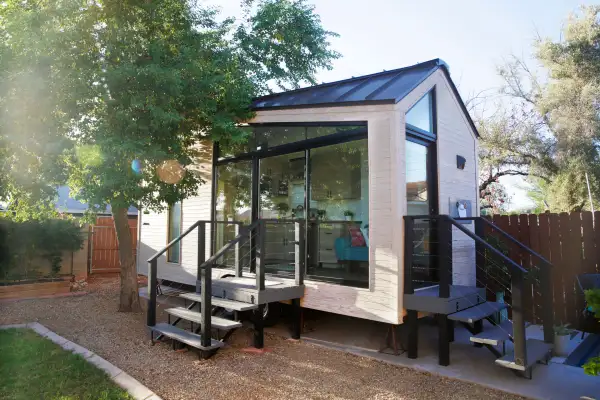Adding an 'Accessory' Home to Your Property? Ask These 7 Questions First

Tired of looking at your empty basement, garden shed or unused garage and wondering how to put it to better use? You’re not alone.
The most recent and comprehensive look at America’s accessory dwelling unit (ADU) boom — a 2024 study from the Federal Reserve of San Francisco — estimates there are about 1.6 million of these add-on living spaces across the U.S., up from roughly 1.4 million in 2020.
With housing inventory so limited — especially in places where there’s not much land left to build on — that number is expected to keep climbing. States like California, Washington and Maine have already passed laws to make it easier for homeowners to add ADUs, and at least eight more states have introduced similar bills since 2024.
The appeal is clear. In a housing market this tight, ADUs offer homeowners who’ve outgrown their space a practical way to expand without the cost and disruption of moving. They’re also adaptable spaces that, in many cases, can transition from a nanny’s room to a rental unit to a home office without much hassle.
Still, diving into an ADU project isn’t something you should rush into. You’ll need to balance the upsides against the costs (which can add up quickly) and, depending on where you live, tricky permit rules may limit what you can actually build.
Here are a few key questions to think through before you get started.
1. What exactly is an accessory dwelling unit (ADU)?
Let’s start with the simplest question — which, incidentally, is trickier than it might seem.
A lot of people assume an ADU can be anything that adds extra space to your home — like a finished basement, a converted attic or a garage that’s been turned into a hangout area — but in reality, it has to function as a self-contained home. According to Freddie Mac, that means it needs a separate entrance, a kitchen and working plumbing.
An ADU can be attached or detached from the primary home. Attached units include spaces like an attic or basement that have been turned into a “granny flat” or an “in-law suite.” Detached ADUs, on the other hand, can be apartments built over a garage, or standalone structures like a she-shed or a pool house that’s been converted into an Airbnb. Either type of ADU can serve as a short-or long-term rental unit.
2. Is it legal to build an ADU where I live?
Legal requirements for ADUs vary widely. Depending on your local zoning laws, you may need a building permit and separate approvals for the installation of electrical, plumbing and heating and ventilation systems.
Some areas require minimum lot sizes or setbacks (the distance a structure must be from the property line). Others have owner-occupancy rules, meaning you must live on the property to rent out an adjacent ADU.
Check with your local planning or development board for a full list of required permits. Fees and approval times vary, but expect the process to take anywhere from a few weeks to several months.
3. How much will building an ADU cost me?
According to the renovation marketplace Realm, the typical ADU in the U.S. costs around $175,000 — a far cry from the roughly $512,800 price tag of the average American home.
That said, the actual cost of an accessory dwelling unit can vary a lot depending on size, design and location. Larger, more complex designs with multiple bedrooms, a full kitchen and additional living space can cost upwards of $300,000.
In addition to construction costs, you also need to consider other expenses such as design costs, permit fees and utility connection costs. You can hire an architect and contractor to design and build your ADU, but many people just work with a company that specializes in accessory dwellings and takes care of everything from the design to the final build.
Some of these companies offer pre-fabricated or modular designs — pre-designed and built homes that only require on-site assembly — to choose from.
You can find design options online, but it’s usually better to work with a local ADU contractor so you can see the designs in person and get cost estimates that fit your area.
4. Can I finance the cost of an ADU?
You won't be able to take out a "regular" mortgage to build an accessory dwelling unit, but you have several other financing options. According to Whitney Hill, co-founder and CEO of accessory dwelling unit design firm SnapADU, one way to finance a build is to use a home equity loan or line of credit (HELOC), if you can afford the extra payments.
You can also look at a cash-out refinance, or take out a construction loan or an FHA renovation loan, which can be used to add extra space to an existing property. If you're 62 or older, a reverse mortgage could be a good option: You can tap into your home equity to fund the remodel or new build without adding a monthly payment to your budget.
No matter which option you’re leaning toward, it’s a good idea to run it past a financial advisor to make sure it fits your long-term goals. You should also review your budget with your lender to make sure you’re not stretching it too thin.
"It's important to ensure your financing plan aligns with the all-in costs of building an ADU," Hill says. "Doing so ensures your project stays on budget."
5. Will an ADU increase my home's value?
In big cities, properties with an accessory dwelling unit command a 35% premium on average, according to a 2021 study by Porch.com. Outside of major metropolitan areas, though, the increase in value tends to be more modest — if it exists at all.
In parts of the U.S. that attract steady streams of tourists or where short-term college housing is in high demand, an ADU can indeed boost resale value. The same goes for suburban or rural neighborhoods where multi-generational living is common, or where long-term rentals are scarce.
As a general rule, two or three-bedroom ADUs that can accommodate a family are likely to generate the most value because they “offer potential rental income, increased living space and flexibility for future buyers," according to Paul Dashevsky, co-CEO at MaxableSpace.com.
6. What are the risks of building an ADU?
Adding an ADU can pay off, but it’s not without headaches.
Higher maintenance, utility and tax costs are usually part of the deal, and hidden expenses like site grading and design fees can pop up unexpectedly and push you over budget.
Local laws on zoning and permitting also vary widely, even in cities and states that have ADU-friendly regulations. For some homeowners, this leads to unexpected delays, red tape and design compromises.
If your goal is to rent out your ADU, keep in mind that the cramped living conditions could make it hard to find tenants, especially if there are roomier options nearby. And while many buyers see ADUs as a plus, others may shy away from the prospect of sharing space with tenants or taking on the hassles of being a landlord.
Remember, resale value depends on your local market; in some areas, the added living space may have less appeal.
7. What are my alternatives?
If an ADU isn’t in your budget, you’ve still got options for adding extra space without overspending.
Remodeling or repurposing what you already have is often the most affordable route. A smaller project — like turning your basement into livable space or adding a prefab “she-shed” — can make your home feel much roomier for a fraction of the cost.
If you’d prefer to add a separate dwelling to your property, consider a tiny home. These compact units can be as small as 100 square feet and can start in the low $10,000-s. Many are mobile, too, so you can move them if your needs (or address) happen to change.
No matter which direction you choose, do a little homework first. Check your local regulations, explore your options and choose one that actually works for your lifestyle — and your budget.


